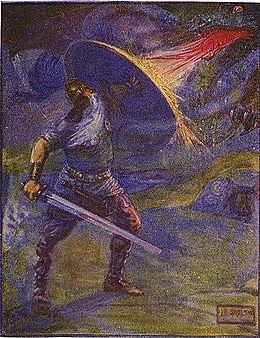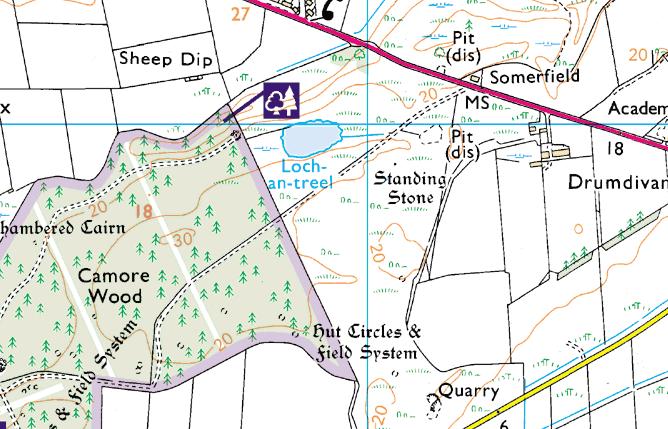The Dragon of Dornoch? January 26, 2014
Author: Beach Combing | in : Medieval , trackbackDragons… It has been so long. The last dragon story of kinds was the serpent crown in the summer of 2012 and the last proper dragon tale was back in spring of 2012, a seventeenth-century Essex wyrm. Here, instead, is a fascinating but potentially dodgy source for a twelfth- or thirteenth-century dragon: a letter sent to a newspaper in 1933! Its author, David Rose was an established Scottish antiquarian, who wrote, however, on some unusual themes including the Loch Ness Monster and a suspect earthquake. Beach first ran across this story in Roland Watson’s The Water Horses of Loch Ness and found the full letter typed up by Ron Patrick from Ontario. It was apparently published in The Scotsman 1 Jan 1934, perhaps in the wake of the Nessie frenzy that had engulfed the Highlands the year before: David Rose had sent it 28 Dec 1933.
Sir: A curious story, handed down in local tradition, about the dragon of Dornoch ought really to be tested. According to the tale, the dragon was slain by Gilbert of Moray, Bishop of Caithness.
Rose goes on to date Gilbert of Moray’s ‘rule’ as bishop from 1222 to 1245.
According to the [oral] story, Gilbert must have been residing near Dornoch when a terrible dragon, which infested the woods and lochs of the muirs to the west, created great alarm in the little city. The dragon had a penchant for plump little girls; he was a lengthy brute, with a long neck, and as he lumbered along the street he would put his head in at a window, and gobble up a fair maiden. No one dared to attack the beast, for he could spout flames.
In my modest experience (and it really is modest) British dragons don’t spout fire, but let this go and there is the Beowulf dragon… In any case, back to our hero the bishop: BTW the detail of a bishop with bows and arrows would be more at home in Ireland where some members of the clergy were expert killers
When Bishop Gilbert heard about the doings of the beast he determined to kill it. The dragon usually came along a well defined path from the woods of Camore, by Loch-an-Treel, where it used to slake its thirst preparatory to its raid on Dornoch. St Gilbert hit on a plan to destroy the beast, which was called ‘Dhu Guische’- the meaning whereof I leave to some kindly Gaelic scholar. Gilbert caused a long shallow tunnel to be dug in its path, having peepholes at intervals. Soon afterwards word was brought to Gilbert that the dragon was seen in the woods on its way to Dornoch. So Gilbert sallied forth with bow and quiver, and popped into the first hole to await the beast. When the dragon came within range Gilbert let drive an arrow, and then scuttled along the tunnel to the next hole, blocking the entrance after him. He peeped out of the hole number two to see the dragon spouting fire into hole number one. Gilbert let drive more arrows, and scuttled along to the next hole. He followed this method of attack until looking out of the last hole he saw the dragon weltering in its gore. They buried the dragon at the ‘Stone of the Beast” which still exists near Loch-an-Treel in Camore Wood.
This is presumably the ‘standing stone’ on the map below. Rose continues, clearly, enjoying himself.
Now, I venture to suggest the story ought to be tested by experts making excavation at the ‘Stone of the Beast’. Amateurs ought not be allowed to make search. A mere fragment of the remains would give a clue as to the species, and anyway it would be of interest to discover the reason for the existence of the ‘Stone of the Beast’. If the remains of the ‘Dhu Guische’ or dragon, be found and reconstructed it would prove a gold mine for the burgh of Dornoch, if they placed the figure of the dragon in the centre of a maze, and made a small charge for inspecting it- I am &c.
A couple of points. Dhu Guische should be ‘the black ?something?’ drbeachcombing AT yahoo DOT com NB guische in French means ruse or deception: the spelling is also strange for a transcription from an oral source. It couldn’t be that old David Rose is having us on, could it? Beach would like to learn some more about this gentleman’s credentials and honesty before putting this tale down to trust or, indeed, what he says about Nessie or earthquakes: as the Italians opine ‘there is the smell of something burnt…’ Alternatively, if anyone has good spade technique perhaps a little digging is in order? Roland Watson offers some sensible advice for anyone who is tempted: ‘I suggest any prospective excavator consults with the local council before they unpack their spades in search of dragon bones.’ 2014 is not, unfortunately 1934.
26 Jan 2014: An old friend of this blog, Borky sends in the following two accounts from the Folklore Journal 6 (1888). Given this my mistrusting probing campaign against DR probably needs to come to an end. I’m not quite ready to apologise yet (though that will come) but I’m well on my way to doing so. In any case over to Borky: ‘v.—St. Gilbert and the Dragon. There lived once upon a time, in Sutherland, a great dragon, very fierce and strong. It was this dragon who burnt all the fir-woods in Ross, Sutherland, and the Keay, of which the remains, charred, black, and half decayed, may now be found in every moss. Magnificent forests they must have been, but the dragon set fire to them with his fiery breath, as he rolled over the whole land. Men fled from before his face, and women fainted when his shadow crossed the sky-line. He made the whole land a desert. And it came to pass, that this evil spirit, whom the people called “the Beast,” and Dhu guisch (of the black firs), came nigh to Dornoch, as near as to Lochfinn, from whence he could see the town, and the spire of St. Gilbert—his church. “Pity of you, Dornoch!” roared the dragon. “Pity of you, Dornoch!” said St. Gilbert; and taking with him five long and sharp arrows, and a little lad to carry them, he went out to meet the “Beast.” When he came over against it he said, “Pity of you!” and drew his bow. The first arrow shot the Beast through the heart. He was buried by the townspeople. Men are alive now who reckoned distance by so or so far from “the stone of the Beast,” on the moor between Skibo and Dornoch. The moor is now planted, and a wood called Caermore waves over the ashes of the fir-destroying dragon.—(From Alexander the Coppersmith.) vi.—The Salamander. The dragon killed by St. Gilbert (before-mentioned) must have been a salamander, since it was born from a fire which has lasted seven years. It lived in fire, and its breath burnt all the forests of the Highlands: only a man who should see it before it saw him had power to slay it. St. Gilbert dug a hole and hid himself in it, so as to get the first sight of it. Gilbert finished his cathedral in Dornoch by witchcraft; he worked at it himself, and he used to fling up the nail to the spot he meant it to occupy, and sent the enchanted hammer after it. They both did their duty, and the hammer then returned to the hands of this “master-mason.” He is called “Holy Gilbert,” and sometimes “Gilbert Saor.”—(From Mrs. McKay.) [Holy Gilbert was really a bishop of Caithness, surnamed Carthophila]’ Thanks Borky and a half sorry to DR!




